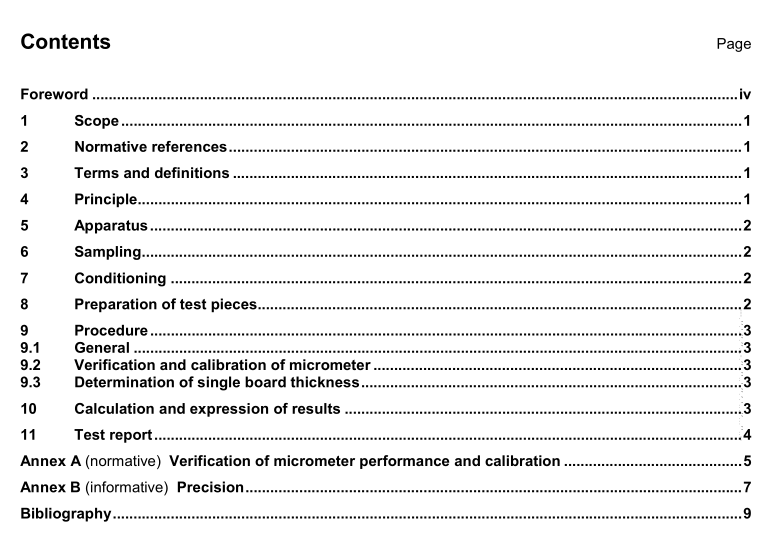ISO 3034 pdf download

ISO 3034 pdf download Corrugated fibreboard — Determination of single sheet thickness
1 Scope
This International Standard specifies a method for determining the single sheet thickness of corrugatedfibreboard intended for use in the manufacture of packing cases.
This International Standard is applicable to all types of corrugated fibreboard.
2Normative references
The following referenced documents are indispensable for the application of this document.For datedreferences,only the edition cited applies. For undated references,the latest edition of the referenceddocument (including any amendments) applies.
ISO 186,Paper and board -Sampling to determine average quality
ISO 187,Paper, board and pulps — Standard atmosphere for conditioning and testing and procedure formonitoring the atmosphere and conditioning of samples
3 Terms and definitions
For the purposes of this document, the following terms and definitions apply.3.1
corrugated fibreboard
board consisting of one or more sheets of fluted paper glued to a flat sheet of board or between severalsheets
[lsO 4046-4:2002, definition 4.49]
3.2
single sheet thickness corrugated fibreboard
distance between one surface of a corrugated fibreboard and the other, measured under an applied static load,using the test method specified in this International Standard
4Principle
Measurement of thickness of corrugated board under a specific static load by means of a high-precisionmicrometer.
5 Apparatus
5.1 Dead-weight micrometer, provided with two plane, parallel, circular pressure faces, between which the corrugated board is placed for measurement. The pressure exerted between the pressure faces during the thickness measurement shall be 20 kPa ± 0,5 kPa. NOTE Other methods exist that use alternative pressures; however, different loading pressures might not give the same results. The two pressure faces shall form an integral part of the micrometer, such that one face is fixed (the anvil) and the other is movable, in a direction perpendicular to the plane of the fixed face, smoothly at a speed of 2 mm/s to 3 mm/s. One face shall be 35,7 mm ± 0,3 mm in diameter and the second face shall be of such a size that it is in contact with the whole area of the other face when the micrometer reads zero. Thus, a circular region of a test piece, 1 000 mm 2 ± 20 mm 2 (10 cm 2 ± 0,2 cm 2 ) in area, is subjected during the thickness measurement to the pressure exerted between the faces. The instrument shall be sufficiently accurate to permit measurements to be made to the nearest 0,05 mm (see Annex A).
The performance requirements of the micrometer shall be such that, when calibrated according to the method given in Annex A, the micrometer complies with the required pressure of 20 kPa ± 0,5 kPa and the performance requirements as shown in Table 1 (see also 9.2).
5.2 Thickness gauges (to be used in A.4), corresponding to approximately 10 %, 30 %, 50 %, 70 % and 90 % of the full-scale reading of the micrometer. The thickness of each gauge shall be known to an accuracy of 5 µm. 6 Sampling If the tests are made to evaluate a lot, select the sample in accordance with ISO 186.
If the tests are made on another type of sample, make sure that the specimens taken are representative of the sample received. 7 Conditioning Condition the specimens in accordance with ISO 187. 8 Preparation of test pieces Prepare the test pieces in the same standard atmospheric conditions as used to condition the specimens. The test pieces shall normally be free from any damage or other irregularities and, unless otherwise agreed between the interested parties, free from converting machine marks, printings, etc. that may affect the test results.
If the thickness of a printed sample is desired, all measurements should be performed in printed areas. Testing can be done on a variety of samples in different states of quality to achieve various goals of process understanding and troubleshooting. Specimens should be representative of the materials being tested. If the test specimens are to be taken from corrugated shipping containers, they should be taken from areas away from scorelines, joints and closures. Unless otherwise agreed upon between interested parties, specimens should not be taken from obviously damaged areas and/or areas not representative of the container as a whole. Select, at random, at least 5 specimens large enough to permit the cutting of at least 10 test pieces (two from each specimen). Cut from the specimens, test pieces each with an area of at least 10 000 mm 2 (100 cm 2 ), either square or circular (of diameter 112,9 mm). If only one test piece can be cut from each specimen, select 10 specimens and cut one test piece from each. Ensure that the test piece dimensions are not so large that the micrometer reading is affected by the test piece mass that overhangs the lower pressure face while a measurement is being made.









